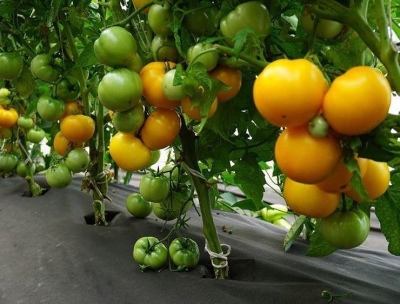
- Authors: Siberian selection
- Category: grade
- Growth type: determinant
- Appointment: universal
- Ripening period: mid-early
- Ripening time, days: 105-115
- Growing conditions: for open ground, for greenhouses
- Bush size: undersized
- Bush height, cm: up to 40
- Bush characteristic: powerful, strong
Yellow tomatoes stand out in the garden and delight the eye with a bright color. It is believed that they are healthier than their red counterparts, so gardeners are increasingly growing them on their plots. The variety of Siberian selection Zolotaya Kluzha has excellent characteristics and is confidently gaining popularity in different regions of the country.
Breeding history
In 2019, the variety was added to the Klusha tomato line. Its predecessors - the red Klusha variety, registered in 2009, and the Superklusha (pink) variety - have already won the love of consumers, and the novelty, in addition to color, repeats the main varietal characteristics of the series. The funny name is explained by the similarity of a low, spreading bush with a ruffled brood hen, which carefully hides its brood under lush feather leaves.
The series was developed by breeders of the Siberian Garden agricultural firm. Since 2007, this large company from Novosibirsk has been breeding, testing and selling seeds of cold-resistant vegetable varieties. In terms of seed sales, Sibirskiy Sad AF is the industry leader in Russia.
Description of the variety
Medium-early high-yielding frost-resistant universal variety Zolotaya Kluzha forms powerful undersized shrubs of the standard type with golden tomatoes of excellent dessert taste.
The main qualities of the fruit
Tomato Zolotaya Klusha is distinguished by its golden-yellow, even rounded, medium-sized fruits weighing from 150 to 250 g. The skin of tomatoes is elastic, shiny, thin, but elastic and dense, does not crack. The fragrant flesh on the cut is also golden, fleshy, tender and juicy, with few seeds.
It is recommended to remove these tomatoes at the stage of ripeness and immediately use them or use them for harvesting. If the crop is harvested unripe and left to ripen, then the taste of such fruits will be lower: the sugar content will decrease, the pronounced aroma will disappear. Perhaps the only drawback of the variety is poor keeping quality, but tomatoes will tolerate short transportation perfectly.
Taste characteristics
Like other varieties of yellow-orange tomatoes, this variety contains less of the beneficial antioxidant lycopene compared to red relatives, but does not cause allergic reactions. Also, yellow fruits have a high level of vitamin A and a low acid content and are recommended for dietary nutrition in case of stomach diseases.
The fruits of the Golden Clush are distinguished by their sugar dessert taste and versatility. They are suitable for fresh consumption in slices and salads, they can be used for pickling and preservation.
Ripening and fruiting
Golden Cludge is considered to be a medium early variety intended for cultivation in the open field and in greenhouses. Ripening of tomatoes occurs 105-115 days after the first shoots appear. Fruiting is abundant and long, depending on the timing of planting, the harvest is harvested from July to early September.
Yield
All tomatoes of this line are declared by the manufacturer as high-yielding: about 10 kg of the fruits of the Golden Klush are harvested from a plot of 1 m². One bush gives up to 2.5 kg.
The timing of planting seedlings and planting in the ground
Sowing for seedlings is usually carried out 50 days before transplanting the bushes to the site.The seeds can be pre-soaked in a solution of potassium permanganate and treated with a growth activator. With the appearance of the first full-fledged leaves, the plants dive into different containers with prepared fertilized soil. Young seedlings can be hardened, periodically exposed to the sun and open air.
Seedlings of the Golden Cludge are absolutely not prone to stretching: the bush turns out to be lush and strong, with dense foliage. The seedlings are transferred to the cleared area when the soil warms up after winter and the threat of frost has passed: in late April - early May.

Growing tomato seedlings is an extremely important process, because it largely depends on whether the gardener will be able to harvest at all. All aspects must be taken into account, from seedbed preparation to planting in the ground.
Landing scheme
The variety forms a strong and low, up to 40 cm, determinant type bush. The root of the plant is compact, so up to 6 bushes can be comfortably placed on 1 m2, but most often they use a 50x50 cm scheme, placing it on 1 square. m 4 seedlings, which should not be excessively buried in the ground.

Growing and care
Even inexperienced gardeners will be able to get a stable harvest of the fruits of the Golden Clush, because this variety is surprisingly unpretentious and requires minimal agrotechnical measures. It is not necessary to form a low-growing standard bush; pinching (removal of unnecessary lateral shoots) is also not performed. Tie up only brushes that are heavy from the weight of ripening tomatoes, you can cover the soil with agrofibre or put a layer of hay under the bunches. Plant care includes the usual procedures: loosening the soil, regular evening watering, seasonal fertilization, preventive treatments against insect pests and the phytophthora fungus.




A plant needs different micronutrients at each stage of growth. All fertilizers can be divided into two groups: mineral and organic. Folk remedies are often used: iodine, yeast, bird droppings, eggshells.
It is important to observe the rate and period of feeding. This also applies to folk remedies and organic fertilizers.


Resistant to adverse weather conditions
It is natural that the variety, bred in Siberia, grows with success and gives a bountiful harvest in most regions of Russia and even in the difficult conditions of the Trans-Urals. The variety is hardy, undemanding to the quality of the soil, feels good in the short and cool Siberian summer.

























































































